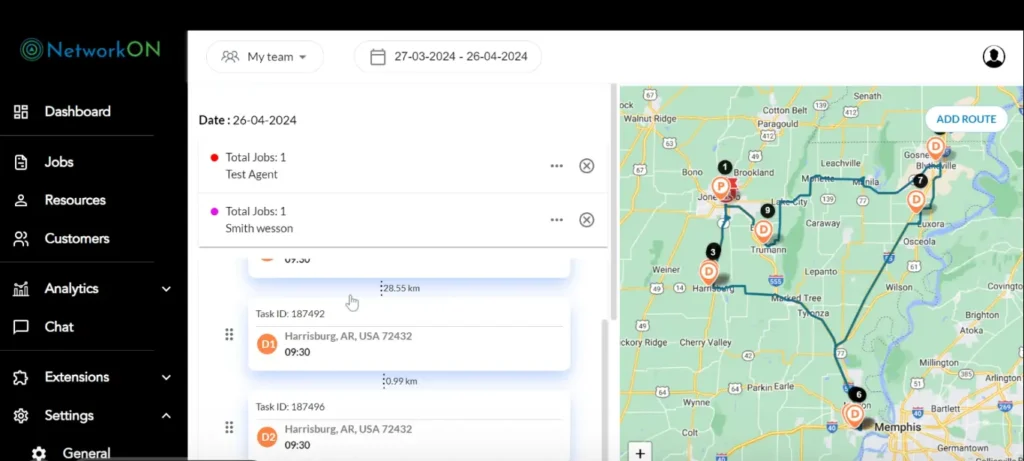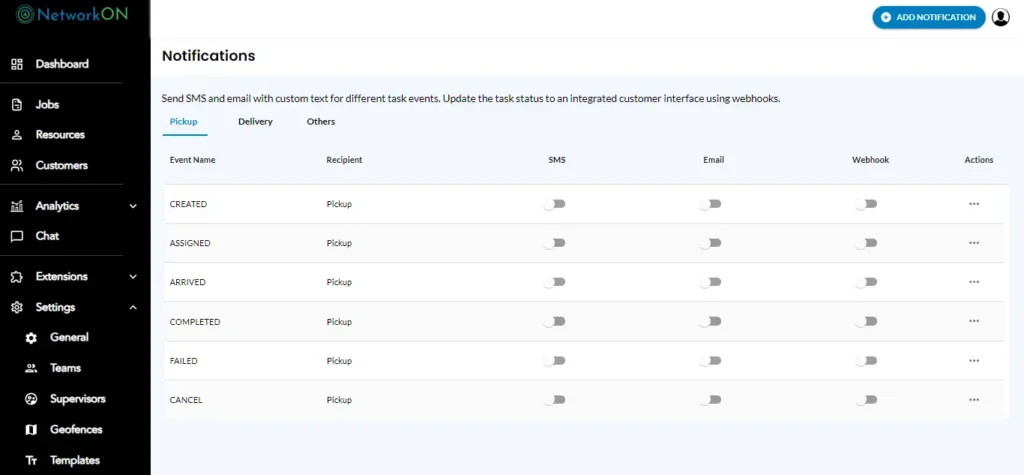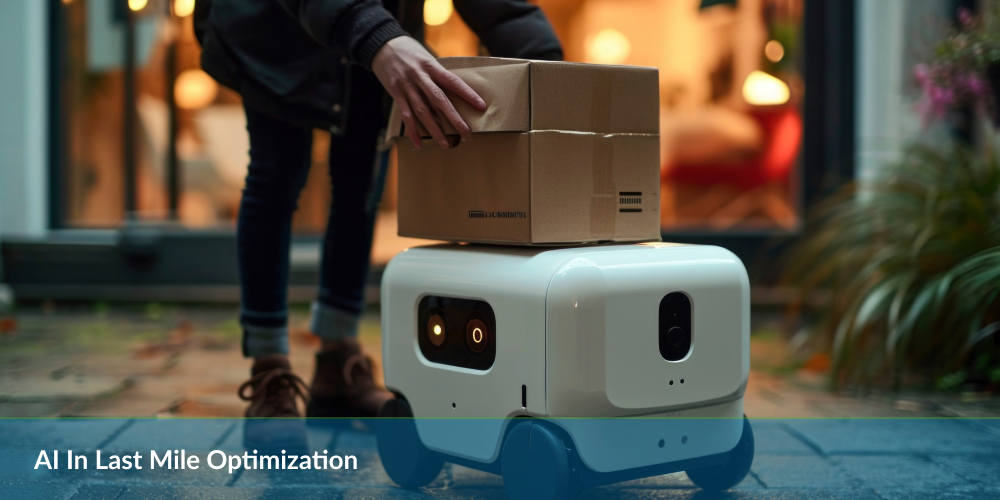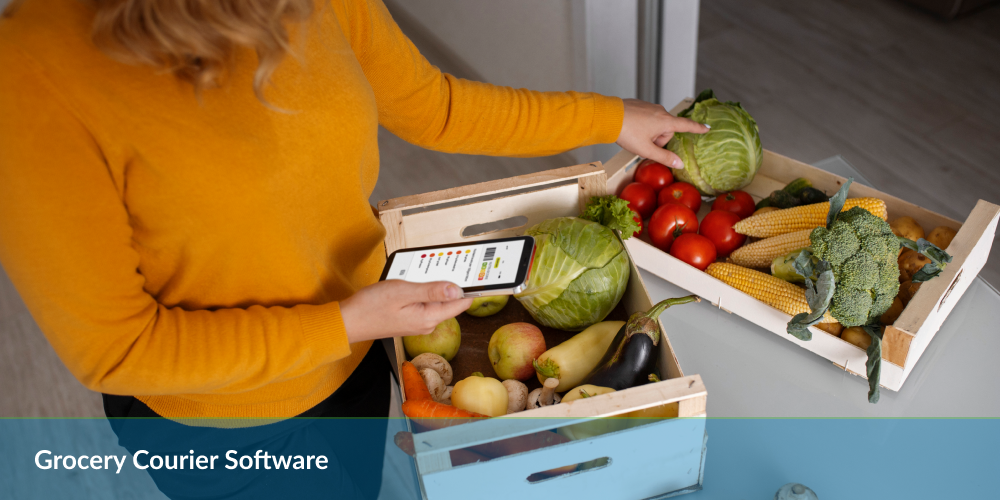Table of Contents
Real-time order visibility provides businesses and customers instant access to an order’s status throughout its journey, from placement to delivery. By harnessing the power of digital systems, this level of transparency reveals the location, progress, and potential issues affecting the timely fulfillment of an order.

Incorporating full visibility into the supply chain transforms operations by enabling proactive management and quick response to any disruptions. For customers, the immediate availability of information regarding their purchases significantly enhances satisfaction and trust.
Enabling Real-Time Insights Through Software
Order tracking software is the technological core, empowering businesses with real-time logistical oversight. This software architecture offers precise tracking and integrates seamlessly with existing systems, leading to a more streamlined, efficient, and responsive operation.
Boosting Supply Chain Efficiency with Order Tracking Software
Effective supply chain management hinges on the seamless flow of goods from suppliers to customers. Order tracking software facilitates this flow. By implementing such a system, logistics managers synchronize activities ranging from procurement to product delivery.
The Symbiosis of Software and Supply Chain Management
Integrating sophisticated order tracking systems with existing supply chains transforms operations. Managers gain the ability to monitor the lifecycle of orders in real time. This visibility streamlines the process and enables proactive management of potential bottlenecks.
Maximizing Shipment Management Efficiency
Order tracking solutions offer a panoply of features designed to fine-tune shipment management. Real-time updates allow for immediate adjustments in routing or scheduling, thus minimizing delays. In addition, digital records reduce the incidence of errors often associated with paper-based systems.
Take, for example, a global electronics manufacturer whose implementation of order tracking software reduced their average shipping time by 20%. Equipped with advanced analytics, the firm identified inefficiencies in its routing protocol and optimized its distribution strategy accordingly.
Driving Customer Satisfaction through Transparent Tracking
In the e-commerce landscape, the direct correlation between order tracking and robust customer relationships must be considered. Customers expect visibility into their purchases; order tracking software effectively bridges this gap. Trust in the service provider grows when such transparency is guaranteed, fostering a healthy, ongoing customer relationship.
Automated alerts and notifications are key functionalities in order tracking systems. These features serve as a proactive approach to communicating with customers about the status of their orders. Rather than customers needing to inquire about their purchases, they receive timely updates. This automation ensures that information reaches customers without unnecessary delays, resulting in increased satisfaction.
Considering the ever-growing trend of mobile usage, accessibility to tracking information via smartphones is a decisive factor in customer contentment. Mobile-ready solutions empower customers to check the status of their orders anytime and anywhere, enhancing their experience and sense of control over the purchase process.
- Seamless integration of order tracking systems with customer notifications creates a stream of communication that supports transparency.
- Customers benefit from receiving information at critical points in the delivery process, which reduces uncertainty and builds anticipation.
- Mobile accessibility places control in the customers’ hands and conforms to modern expectations of convenience and efficiency.
Subsequently, order-tracking software that incorporates these elements does not merely fulfill an operational need; it actively cultivates an environment where satisfaction is a natural outcome. This satisfaction is a competitive advantage, leading to higher customer retention rates and positive brand advocacy.
The Role of Inventory Management in Order Tracking
Effective order-tracking software transcends the realm of mere package monitoring; inventory management becomes intuitive and optimized. By facilitating real-time stock levels and movement tracking, businesses can minimize overstocking and understocking, both known detractors of operational efficacy.
How Order Tracking Software Helps in Managing Inventory
Software geared towards order tracking often provides granular control over inventory. This tool allows for automating stock adjustments post-order placement and upon receipt of goods, maintaining an accurate count. Sophistication in this software enables anticipating demand and incites proactive inventory reordering, eliminating the common pitfall of stockouts. By closely monitoring inventory turnover rates, the system also aids in identifying slow-moving items that tie up capital and storage space.
Use of Barcode Scanning and RFID Technology in Inventory Control
Incorporating barcode scanning and RFID technology into inventory management brings substantial efficiencies. When scanned, barcodes immediately update inventory levels, all but eliminating manual entry errors. RFID tags contribute further, allowing tracking items without line-of-sight, enhancing process speed, and providing data-rich tracking. These technologies intertwine with order-tracking software, enabling a fluid and continuous inventory monitoring system.
Integration of Order Management Systems for Seamless Operations
An integrated order management system forms the backbone of sophisticated order-tracking platforms. This convergence crafts a seamless transition between order placement, fulfillment, and inventory management. As orders are processed, inventory levels update in concert, reflecting current availability and leading to informed decisions on purchasing and stock allocation. Thus, the entire supply chain feels the impact of enhanced synchronization, reducing lags in information flow and bolstering the capability to deliver to customers swiftly and accurately.
The Edge of Carrier Integrated Solutions
Carrier integration represents a transformative approach to shipping logistics, encompassing the automated data exchange between a business’s order tracking system and the various transportation carriers used to deliver goods. With this system, companies fuse their digital infrastructure with carrier services to streamline the communication process, which is crucial for real-time tracking and the timely delivery of packages. By integrating carriers directly into their order tracking systems, businesses can monitor shipments from when an order is placed until it reaches the customer’s doorstep, offering a comprehensive view of the package’s journey.
With integrated solutions, carrier selection and cost analysis have become less complex, as systems can present an array of rates and options within a single interface. This simplicity in choosing an optimal service based on cost, delivery time, and carrier performance standards enables businesses to make informed decisions swiftly, often leading to significant cost savings and enhanced delivery performance.
- Integrated carrier options empower comprehensive shipment monitoring and control during transit.
- Rate comparison empowers businesses to select the best value option, optimizing for speed, cost, and reliability.
- Direct integration mitigates the need for manual data entry, reducing errors and increasing operational efficiency.
Last-Mile Delivery Optimization Tactics
Last-mile delivery presents a complex challenge within the logistics sector, demanding meticulous coordination and execution. Tracking software refines these last-mile processes through targeted strategies. Logistics providers enable more efficient routing, real-time adjustments, and enhanced delivery precision by integrating precise tracking capabilities.
Strategies for Fine-tuning Last-mile Delivery
Diverse tactics leverage order-tracking software to streamline the final phase of delivery. These include:
- Dynamic routing algorithms that tailor delivery paths based on traffic patterns, road conditions, and customer availability ensure that the shortest and fastest route is selected, leading to faster deliveries and fuel savings.
- Real-time communication channels between dispatchers and drivers, supported by tracking software, allow for immediate updates and course corrections, which can be pivotal in avoiding delays.
- Predictive analytics embedded in tracking solutions analyze historical data to forecast potential delivery setbacks, facilitating preemptive measures and thus maintaining reliability.
- Customer-facing tracking systems equip recipients with up-to-date delivery windows and the ability to interact dynamically with their delivery preferences, improving customer experience.
Collectively, these techniques improve delivery accuracy and decrease operational costs by reducing failed delivery attempts and resource wastage.
Consequences of Adopting Last-mile Delivery Software
The deployment of advanced tracking software within last-mile delivery operations directly impacts delivery promptness and cost-effectiveness. Regularly achieving timely deliveries bolsters customer trust and loyalty. At the same time, simultaneous cost reductions emerge through the minimization of redundancies and enhanced delivery density.
Ultimately, the sophistication of order-tracking software transforms the last mile into a competitive advantage rather than a logistical hurdle. By deploying robust software tools, logistics professionals ensure that goods are delivered on schedule and that the process is as cost-effective as possible, solidifying the reputation of the delivery service and upholding customer satisfaction.
Simplifying Return Management
Handling returns in the logistics sector presents a dense matrix of challenges. Once delivered, products that return as returns can become a labyrinth of tracing, assessment, and reallocation. This is where order tracking software enters the equation as a resolver of complexities, returning clarity to the return management process.
Order tracking software transforms the once cumbersome process by integrating return management functions. Customers initiating a return are assured of a straightforward pathway, and logistics managers benefit from centralized return data. As a result, the likelihood of merchandise being restocked rapidly and customers receiving their refunds or exchanges increases exponentially.
Leveraging order-tracking software equips businesses with techniques to mitigate losses associated with returns and exchanges. Analytics features discern patterns in return rates, highlighting potential areas for product improvement or packaging. Automated restocking sequences ensure inventory turnover remains constant, reducing the potential stagnation of capital in dormant stock. Equipped with these tools, businesses handle returns with dexterity, minimizing financial repercussions.
Ultimately, order tracking software forms the nexus between customer satisfaction and logistical efficiency in return processing. By adopting these software solutions, the chaotic terrain of return management morphs into a structured, manageable aspect of e-commerce and retail operations.
Advanced Analytics and Reporting
Order tracking software transcends basic logistics to deliver robust data analytics, enabling businesses to make strategic decisions. With the surge of data in every corner of the commercial sphere, deciphering complex datasets is no longer impossible. Companies can leverage this data to refine their operational models, streamline supply chain processes, and enhance customer satisfaction.
Reporting features embedded within order tracking software platforms offer various benefits. Executives can access customized reports that spotlight trends, identify operational bottlenecks, and monitor performance metrics against strategic goals. Such comprehensive reporting tools aid in making data-driven decisions aligned with the company’s growth trajectories.
By analyzing historical and real-time data, businesses can accurately predict future trends, demand spikes, and potential supply chain disruptions. These insights improve logistics by optimizing inventory levels, better forecasting, and planning for capacity accordingly. Anticipating these factors ensures companies remain competitively agile in an ever-changing market landscape.
- Adapting to market dynamics becomes streamlined with precise trend predictions.
- Enhanced logistic strategies result from in-depth data insights.
- Supply chains become more responsive and flexible as data-driven planning counters unpredictable challenges.
Seamless Order Management System Integration
Assessing the landscape of modern commerce reveals that integrating tracking software with an Order Management System (OMS) creates a streamlined back-office operation. When systems communicate, businesses experience a transformative impact on their ability to manage orders. Below the surface, product movements become transparent while the speed and accuracy of order processing soar.
Benefits of OMS Integration
A harmonious link between order tracking software and an OMS unlocks several advantages. Companies gain the ability to track inventory and order flow in a unified workspace. Response times decrease as customer service representatives access information from a single source, effectively coordinating across various sales channels. Forecasting improves, relying on shared data to better anticipate inventory needs. Tight integration ensures that orders flow seamlessly from receipt to delivery, often reducing operational costs and improving customer experiences.
Best Practices for Software Integration
Certain practices promise a smoother transition for those seeking to align order-tracking software with their OMS. Firstly, ensuring data consistency across systems avoids costly mistakes and maintains data integrity. Establishing robust communication protocols enables different systems to exchange information efficiently. Prioritizing scalability within the integration design allows for future business growth without requiring complete system overhauls. Finally, involving stakeholders from various departments early in the integration process promotes understanding and adoption of the new system capabilities.
- Consistent data enhances reliability.
- Effective communication protocols ensure efficient information exchange.
- A scalable design anticipates growth needs.
- Stakeholder involvement encourages system-wide adoption and utility.
Artificial Intelligence and Machine Learning: The Game Changers
Artificial Intelligence (AI) and Machine Learning (ML) are reshaping the landscape of order tracking and logistics with unprecedented transformations. By harnessing these technologies, companies unlock advanced predictive analytics capabilities, facilitating automated decision-making processes that far surpass the accuracy and efficiency of human input.
Transformative Impact on Tracking and Logistics
AI-driven systems analyze vast amounts of historical data, detect patterns, and predict future trends, which allows stakeholders to manage inventory and optimize supply chains proactively. ML algorithms constantly learn from new data, ensuring that the predictions and insights become more accurate over time. This leads to a more dynamic approach to inventory management, demand forecasting, and route optimization.
Predictive Analytics and Automated Decision-Making
Through predictive analytics, order tracking software anticipates delays, suggests optimal shipping routes, and predicts the best times to restock products. Automated AI-driven decision-making streamlines operations, reduces human error, and increases efficiency. In response to predictive insights, real-time adjustments to shipping routes and schedules occur, preventing potential disruptions before they arise.
Enhancing Tracking with Barcode Scanning and RFID Technology
Barcode scanning and RFID technology form the backbone of modern order-tracking systems. These technologies advance the operational capabilities of warehouses, distribution centers, and retail businesses by ensuring that items move through supply chains with remarkable speed and accuracy. With the implementation of these systems, manual entry errors diminish significantly, and inventory tracking becomes a more streamlined process.
The Technological Backbone of Modern Order Tracking
These tracking enhancements stem from the sophisticated data capture methods used in barcode and RFID systems. Barcode scanners convert the visual patterns on barcode labels into digital information that computers can process. On the other hand, RFID systems utilize radio waves to read and capture information stored on tags attached to objects. These tags can be read from a distance and through various materials, enabling more flexibility than barcodes.
Speeding Up the Process and Enhancing Accuracy of Item Tracking
Efficiency is markedly elevated in the presence of RFID and barcode scanning technologies. Warehouse staff can scan multiple barcodes in a fraction of the time it would take to record data manually. RFID technology allows bulk scanning of items, reducing the time and effort required to confirm inventory levels and dispatch orders.
Integration with Cloud-Based Solutions for Real-Time Data
The synergy between barcode and RFID tracking technologies and cloud-based solutions provides access to real-time data across the supply chain. When items are scanned, the data is instantaneously uploaded to cloud servers and accessed from any location. This lets stakeholders track inventory movement and order status in real time, making the supply chain more transparent and responsive.
- Warehouse managers track inventory levels accurately and predict stock needs.
- Sales teams access up-to-the-minute stock information to inform customer inquiries.
- Logistics coordinators optimize shipping and receiving schedules based on real-time data.
Adopting barcode scanning and RFID technology in order tracking systems invariably leads to enhanced operational efficiencies. Businesses ensure that inventory is tracked accurately, data is collected efficiently, and customers remain satisfied with up-to-date information regarding their orders.
The Flexibility of Cloud-based Solutions
Cloud-based order tracking software offers unmatched scalability and accessibility, transforming how businesses monitor and manage shipments. Unlike traditional systems anchored to specific hardware, cloud solutions empower users to access tracking information from anywhere with an internet connection. As businesses grow, these systems adapt seamlessly, scaling up to accommodate increased order volumes and complexity without significant capital investment in server infrastructure.
Business expansion benefits from the agility of cloud-based order-tracking software. With such systems, new market entry or portfolio diversification proceeds with minimal adjustments to the technological framework. The software’s capacity to integrate with an array of carriers and shipping services worldwide ensures that the foundational tracking mechanics require no overhaul, notwithstanding the business scale.
Nevertheless, data security remains a paramount consideration within cloud services. Reputable cloud-based order tracking solutions uphold stringent security protocols, encrypting data in transit and at rest. They also undergo regular security audits to maintain compliance with international standards, assuring businesses that their sensitive information is protected against unauthorized access and cyber threats.
The Convenience of Mobile Accessibility
Mobile accessibility transforms order management and tracking processes, providing the capability to manage and monitor orders from anywhere. Users can receive updates, adjust orders, and communicate directly with suppliers or logistics teams from their mobile devices. This ubiquity ensures stakeholders remain informed and agile in their operations.
Software solutions must operate across multiple devices, ensuring consistent functionality and experience. Professionals frequently transition between desktops, tablets, and smartphones; therefore, order-tracking systems must support this cross-device fluidity. This seamless experience allows for quicker decision-making and enhanced productivity.
- Managers access real-time order statuses during site visits or while commuting.
- Warehouse operators update inventory levels instantaneously, directly from the warehouse floor.
- Customers track their orders with just a few taps on their smartphones.
Order tracking apps often include features such as push notifications, which notify stakeholders immediately when there’s a relevant update. This means that critical information is relayed without delay, enabling prompt action. For instance, a courier receives a notification about a change in delivery schedule and reroutes to maintain efficiency.
The depth of mobile integration in order tracking software represents a significant leap forward for businesses striving to maintain continuity in an increasingly mobile-dependent world. Accessibility translates to uninterrupted workflows, enhanced control over logistics, and, ultimately, higher levels of customer satisfaction due to improved service delivery.
Streamline Communication with Automated Alerts in Order Tracking
Order tracking software is a linchpin for seamless communication across a business’s operational framework. These sophisticated systems proactively keep stakeholders apprised of order statuses by deploying automated alerts and notifications. Instant updates are no longer luxuries but expected standards that bolster efficiency and enhance decision-making processes.
Custom Notifications Tailored to Stakeholder Roles
The agility of order-tracking solutions lies in their ability to disseminate tailored information. For instance, a warehouse manager receives alerts about incoming orders requiring space allocation, while a customer success agent gets notified about potential delivery delays, enabling proactive customer communication.

Customizable alerts ensure all parties receive relevant, timely information, fostering a robust information flow aligning with their unique responsibilities.
Minimizing Tedious Manual Updates
Before the advent of sophisticated software, updating order status for clients and internal teams was a time-consuming chore, often prone to error. Today, order-tracking software mitigates the need for such manual interventions. The system automatically relays critical information, reducing the need for phone calls and email updates that once consumed valuable hours.
- Warehouse staff are promptly informed about stock requirements, expediting the picking and packing processes.
- Customer service representatives can anticipate inquiries with up-to-the-minute data, preparing them for a more informed customer engagement.
- Logistics coordinators are kept in the loop about transit status, assisting in coordinating subsequent logistical tasks.
With each stakeholder armed with the latest information, coordinated actions are taken more swiftly, contributing to the uninterrupted flow of the supply chain. Ultimately, harnessing the power of automated alerts and notifications within order tracking systems augments operational transparency and catalyzes elevated service levels and operational excellence.
Ensuring Compliance and Security Features in Tracking Software
Logistics operations necessitate adherence to various regulations. Implementing order-tracking software reinforces compliance at every step. Companies that fail to comply with regulatory requirements face hefty fines. Therefore, integrating software that ensures compliance safeguards against potential legal and financial repercussions.
Order-tracking software typically features robust security protocols to protect sensitive customer data. Cybersecurity measures are paramount, as data breaches can seriously undermine a company’s credibility and lead to substantial losses. A robust order-tracking application employs encryption, multi-factor authentication, and regular security audits to thwart unauthorized access and safeguard data integrity.
- Encryption translates data into a code, preventing unauthorized parties from reading it during transmission.
- Multi-factor authentication requires multiple verification methods, significantly reducing the risk of unauthorized access.
- Regular security audits identify vulnerabilities within the system, allowing for timely interventions to strengthen security postures.
Ensuring the order tracking software complies with industry standards such as ISO, GDPR, or HIPAA fosters trust and ensures smooth interstate and international operations. Companies may encounter barriers that could disrupt their supply chain logistics without such compliance.
Data protection laws require diligent handling of customer information. Order tracking software aids in automating this process and providing evidence of compliance through detailed records that prove adherence to legal standards.
Buyers seeking order-tracking solutions must prioritize compliance and security features. This proactive approach will prevent data breaches and ensure smooth operations while building customer trust through transparent and secure order-tracking processes.
Key Takeaways
- Enhanced Visibility and Proactive Management: Real-time order tracking software provides comprehensive visibility into the entire order journey, from placement to delivery, enabling businesses to manage disruptions proactively and enhance customer satisfaction through transparency.
- Operational Efficiency and Cost Reduction: Implementing order tracking software streamlines supply chain processes, synchronizing activities from procurement to delivery. This leads to improved shipment management, reduced delays, and significant cost savings due to optimized routing and reduced manual errors.
- Advanced Technologies Integration: Incorporating barcode scanning, RFID, AI, and ML into order tracking systems enhance inventory management, predictive analytics, and automated decision-making. These technologies enable businesses to efficiently manage stock levels, predict demand, and optimize delivery routes.
- Customer Satisfaction and Communication: Automated alerts, mobile accessibility, and real-time updates significantly improve customer experience by providing timely and accurate information about order statuses. This transparency fosters trust, increases customer retention, and supports brand advocacy.
- Compliance and Security: Robust order tracking software ensures compliance with industry standards and data security protocols, protecting sensitive information and avoiding legal repercussions. Features like encryption, multi-factor authentication, and regular security audits are essential for maintaining data integrity and customer trust.
Conclusion
Order tracking software stands at the forefront of modern logistics, ushering in unprecedented transparency and efficiency in supply chain management. Logistics companies harnessing these advanced solutions experience streamlined operations, with benefits that permeate every aspect of their service delivery—from inventory management to last-mile fulfillment.
To remain competitive and responsive in a dynamic market, comprehensive order tracking systems are not simply a luxury but a strategic imperative. Advances in technology, including artificial intelligence, machine learning, and cloud-based platforms, empower these systems to provide actionable insights, drive customer satisfaction, and enhance overall supply chain resilience.
Enabling real-time updates and integrations with various carriers, businesses ensure an experience that keeps all stakeholders informed and engaged. With the right software in place, inventory accuracy, return management facilitation, and data-driven decision-making are just a few of the transformations companies witness.
When weighing the affordability of order tracking solutions, consider the tangible ROI and the marked improvement in customer loyalty. The cost savings from efficient route planning, reduced errors, and improved inventory turnover time can offset the initial investment in the technology.
Explore and request demonstrations of order-tracking software that could revolutionize your logistical operations. Our team is available for professional consultations to provide deeper insight into specific solutions or discuss your business’s unique needs. Reach out today to ensure your company’s logistics infrastructure thrives in the competitive market.
Are you ready to give your customers the transparency they expect and the efficient service that will set you apart? NetworkON can help you discover the best order-tracking software for your business. Connect with our experts for further inquiries and to understand how implementing these solutions benefits your operations.
Frequently Asked Questions
How does real-time order tracking software improve supply chain efficiency?
Real-time order tracking software enhances supply chain efficiency by providing visibility into the entire order journey, allowing for proactive management of potential disruptions. It streamlines processes from procurement to delivery, synchronizes activities, reduces manual errors, and enables quick adjustments in routing and scheduling, leading to significant cost savings and timely deliveries.
What technologies are integrated with order tracking software to enhance its capabilities?
Order tracking software integrates several advanced technologies, including barcode scanning, RFID, artificial intelligence (AI), and machine learning (ML). Barcode and RFID technologies improve inventory tracking accuracy and efficiency. AI and ML provide predictive analytics and automated decision-making, optimizing inventory management, demand forecasting, and delivery routes.
How does order-tracking software contribute to customer satisfaction?
Order tracking software enhances customer satisfaction by providing real-time updates and transparent communication. Automated alerts and notifications keep customers informed about their order statuses, reducing uncertainty and building trust. Mobile accessibility allows customers to track their orders anytime, anywhere, ensuring a seamless and convenient experience.
What security and compliance measures are in place with order tracking software?
Order tracking software incorporates robust security and compliance measures to protect sensitive customer data and ensure adherence to industry standards. These measures include data encryption, multi-factor authentication, and regular security audits. Compliance with standards like ISO, GDPR, and HIPAA ensures businesses operate smoothly and maintain customer trust by safeguarding their information.




0 Conversations